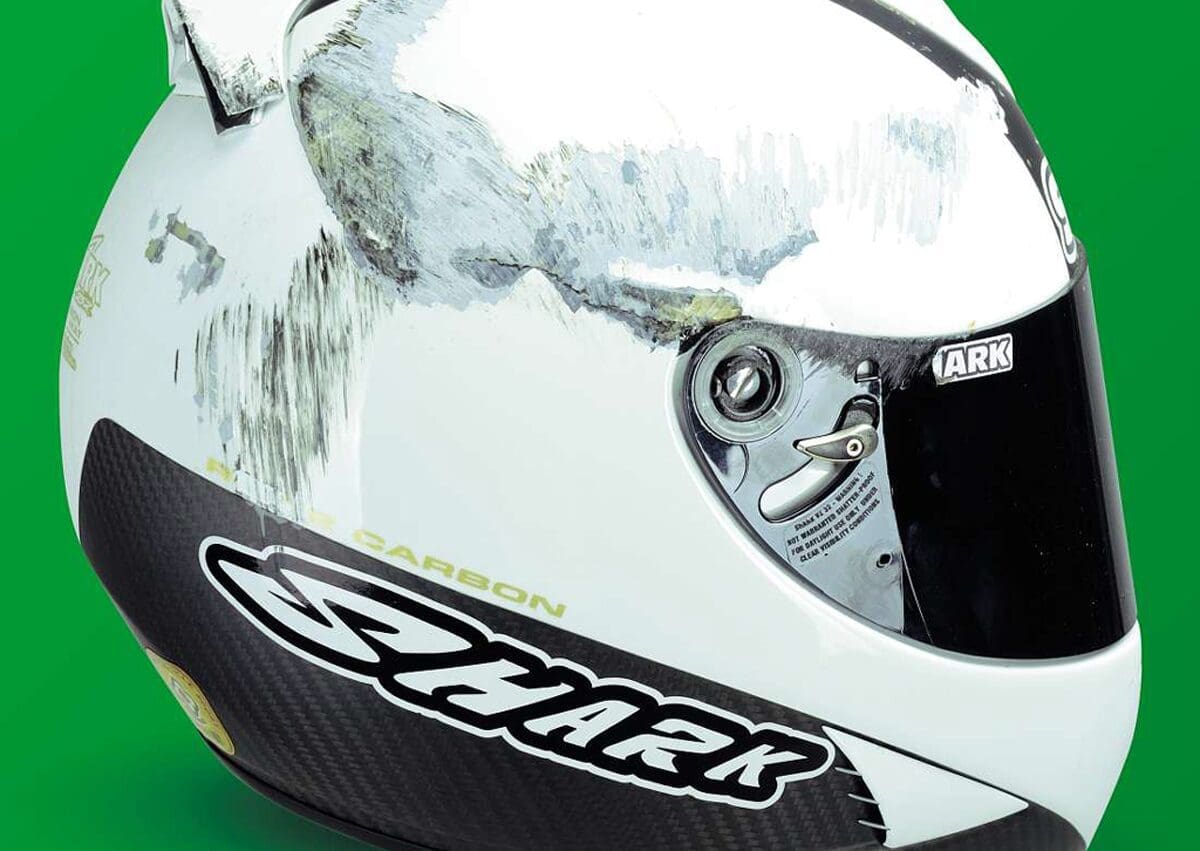
The difference between a bike being the best or worst thing ever is simply down to kit. Get it right and you’ll be warm, dry and safe, get it wrong and you’ll be miserable.
When I first started riding, a smart old bloke said something I’ll never forget. “In a car, you have seat belts, metal and glass to protect you from the elements and the dangers around you. On a motorcycle, you wear your own protection.” He was right.
According to the law, you can ride naked (almost) as long as you wear a crash helmet. But look at it this way. Riding at 60mph is like standing in a 60mph wind. Now at most times of the year in the UK, that’ll be a cold 60mph wind. How long before you’d want to put a coat on?
Next, imagine standing under a power shower on its coldest setting for an hour or so. How long could you stand that for? And finally, imagine being smashed on the elbows and knees with a large piece of tarmac moving at 41 feet per second. Fancy that? Didn’t think so. Me neither.
Thankfully, for a few hundred pounds, you can buy stylish, well-made bike kit that will protect you from all of that and make every ride warm, dry and safer should the worst happen.
Modern materials make weatherproofing affordable and practical, while advances in body armour have made impact protection much stronger than before.
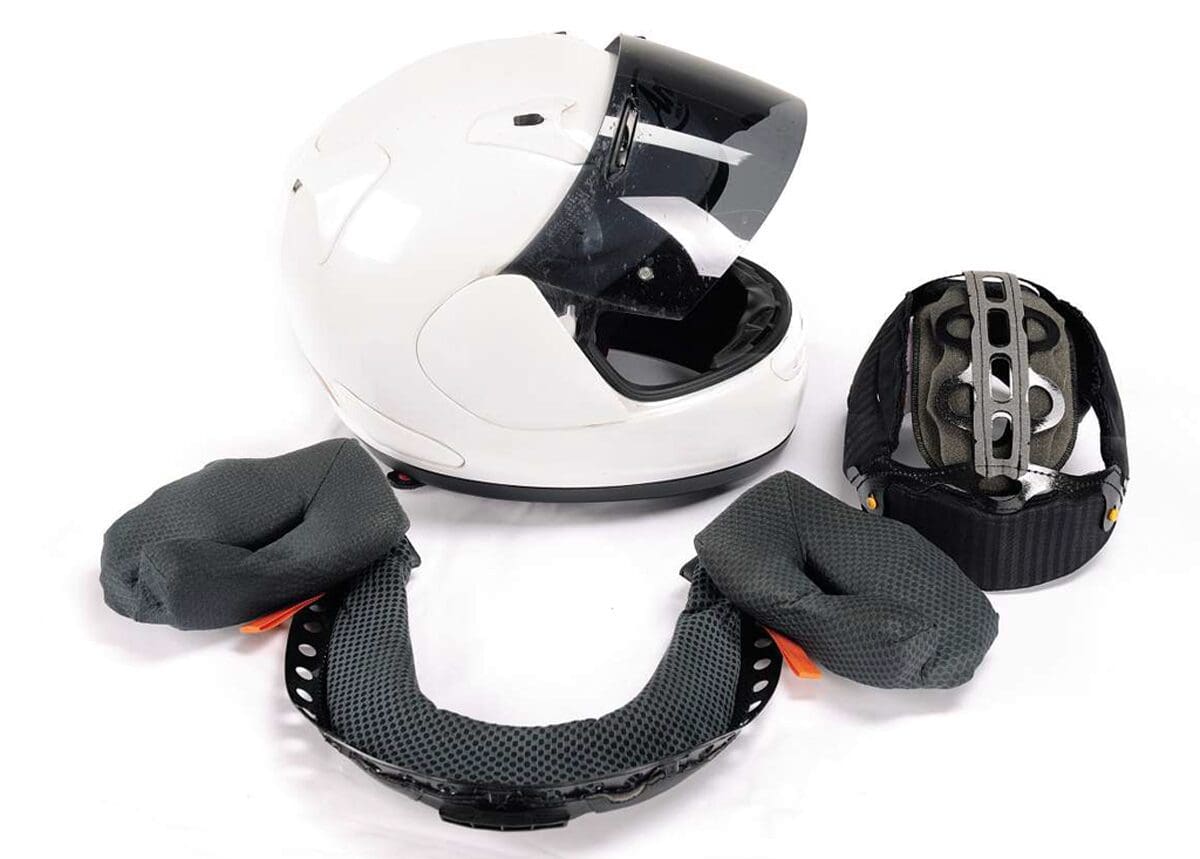
Crash Helmets
How they work
The outer shell offers a little crash protection, primarily against penetration from sharp objects. The actual impact protection happens inside.
One or more layers of shaped polystyrene absorbs the impact of a crash which minimises the actual force transmitted to the head inside. The best helmets use different density polystyrenes in different areas of the helmet to optimise protection.
But crash protection isn’t a helmet’s only job. The visor is designed to give perfect vision and also withstand the impact of flying stones and insects. Some visors are tough enough to stop a bullet and yet thin enough to allow perfect visibility.
As well as the obvious protection areas, a crash helmet also has to protect your ears against the wind noise. Air passing over a helmet at speed makes it resonate, like a bell. The associated turbulence also creates low-frequency sound. Some helmets are quieter than others (generally more vents equals more turbulence which equals more noise).
Riding a motorbike at speed without earplugs will eventually damage your hearing. So the manufacturers work hard on design to keep the noise down, but you’re still better off using earplugs too.
What to look for
There are four things. Fit, protection, price and features. Also important (but impossible to tell in a showroom) is the quality of construction and longevity. There’s no point saving £100 now for your helmet’s lining to drop out or the visor break after six months.
Fit is everything. Not just for the best crash protection, but also to minimise noise and aid comfort too. A good fitting helmet makes all-day rides a pleasure and you arrive feeling fresh and ready for more. A bad fitting helmet is at best a bit saggy and annoying at speed, at worst it’s like having G-clamps fastened to your temples with an extra turn on the clamp every few minutes.
A good fitting helmet sits evenly across your head with no pressure points on your forehead, temples or the back of your skull. Double-D-ring fasteners on the strap are best because you get them as tight as possible every time.
With the helmet on and strap tight, try pulling the helmet off your head from the back. If there is plenty of movement, the helmet is too big -try a smaller size. And don’t assume that because you are a small in an Arai helmet you will also be a small in an AGV.
Manufacturers build their helmets differently. Some also build several different shell sizes so if you are an extra small you don’t have the same shell size as your XXL mate.
Assessing protection is easy. All helmets sold for road use have to conform to the European ECE 22-05 standard and in the UK will wear an ACU (Britain’s racing governors) gold or silver sticker (gold is the highest level of protection).
There is also a Governmentsponsored test for crash protection called the SHARP test. Results are on its website (www.sharp.direct.gov.uk) and helmets are awarded a star rating between one and five. Some manufacturers dispute the validity of some of the tests, but for now, it is the most accurate comparison we have.
Price is a tricky one. If the best fitting, most comfortable, well protecting helmet you try happens to cost just £100 (we wouldn’t recommend spending any less than this), then that’s the one for you.
In general, the most expensive helmets offer more features and better comfort, not significantly increased protection. It’s possible to spend almost £600 on a crash helmet, but in truth, you can get a superb lid with all-day comfort, reasonable noise levels and effective venting for somewhere between £200-300. Which seems like a lot of dosh, but a good fitting, comfortable helmet makes the biggest difference to biking pleasure.
Some features are much more worthwhile than others. Removable, washable linings are definitely a good thing, as is a visor changing mechanism that’s easy to operate. Many helmets now come with a free anti-mist insert that sticks on the back of the visor. These are essential because visor misting in damp or cold conditions is terrifying.
The very top end race helmets are superb for track riding but they can be noisy and their linings are designed for efficient wicking of sweat rather than all-day comfort, so are not always the plushest.
Helmets with a flip-up front are useful, especially for working riders, but they are much heavier than normal helmets (which causes neck strain at first, even from just walking around with it flipped up).
Visors
The law says a crash helmet’s visor must be strong enough to pass the required testing, but also be scratch-resistant and, if tinted, still be able to transmit more than 50% of light through it. Visors with a much deeper tint are available to racers and many road riders wear them. They are illegal on two counts; most aren’t scratch resistant and they don’t transmit enough light.
Thankfully most policemen are smart enough to apply the law sensibly. If you get stopped in bright sunshine and your dark visor is in good condition, chances are it will be — mentioned but go no further. If you get stopped wearing one at night, then you deserve everything you have coming to you. Other tinted options included light-sensitive photochromic antimisting inserts, which cost around £40- cheaper than a dark visor and legal.

Riding suits
A good riding suit does many things. Firstly, it keeps you warm. Then it keeps you dry and most importantly, it protects you in the event of a spill. If you want one suit to do all three of these you’ll be needing a two-piece textile combo with flexible armour in the back, hips, knees and elbows.
These textile suits have many advantages over the more traditional leather ones – mostly that they are warmer and more comfortable. They also tend to have a lot more pockets and can usually be worn over your other clothes, where travelling in leathers means you’ll need something to change into when you arrive. Textiles are also generally waterproof and although you can buy waterproof leather suits, these are expensive and tend not to be so warm (or have as many useful pockets).
Historically, the leather suits progressed through race technology and advances in textiles have come through off-road adventure riding. If you can afford both, then buy both – a set of leathers for summer and textiles for the other three seasons – but if you can only afford one, buy textile.
There are only two significant disadvantages. First, the looser fit means the body armour can slip round in an accident, so use the adjusting straps (pie, right) to maximise impact protection.
Secondly, the textiles used have a fraction of the abrasion protection of leather so should you end up sliding along on your backside, the world will be seeing your ‘golfers have dimpled balls’ underpants in a fraction of the time had you been wearing leather. As with all bike kit, the right fit is what makes the difference. And there are some very different fits between the manufacturers of these suits.
First off, decide whether you want to wear jeans under your textile trousers. Many modern suits are designed to be worn without which enhances the fit and keeps the armour more securely in place. Overtrousers tend to be baggier.
Important trouser choices include the length and quality of the zips or fasteners at the bottom of your leg. They need to be wide enough to get over your boots easily, a snug fit when fastened and robust enough not to break after six months leaving you with flares and a damp crotch on the left and straights on the right. Try the trousers on and assume the position – knees bent and legs apart. Is it still comfy?
Next, is the armour removable? If so, this allows you to replace the often cheap standard kit with some high-performance aftermarket armour, such as that made by Forcefield, turning a budget suit into a great one. At the waist look for zips or other fasteners to attach them to the jacket. Without these, you’ll get a 60mph breeze up your back and water dripping down your bum-crack. Nice. The other alternative is a salopette which also adds an extra warm layer to your chest, back and kidneys, but look as sexy as a radiogram (ask your gran).
Buying a jacket is simpler. Ideally, it will be the matching one to your trousers – that way you know they will fit together properly. But, people being people, the jacket might not f1t you so don’t be shy about trying others. The key thing once again is fit. Places of special importance here are the collar and cuffs. Does the collar fasten comfortably without Velcro chafing your newly shaved morning chin? Once again, assume the riding position (even better, go and sit on a bike in the showroom).
Does the collar still feel comfortable? Are the arms long enough, has the back of the jacket ridden so far up that everyone can see your snowflake tattoo? These are all bad things. A jacket can’t do its job if there are three square feet of pale exposed flesh hanging out. With everything done up, how does it feel? Would there be room for another layer or two in winter? Does the armour move around too easily?
Finally, check the cuffs. How easily can you get them over your biking gloves? It seems odd to some people but cuffs over gloves keeps your hands much drier than the other way around. Getting the first glove on is easy with most jackets, but getting the second one on needs an accommodating jacket. Get this one wrong and you’ll be cursing come February.
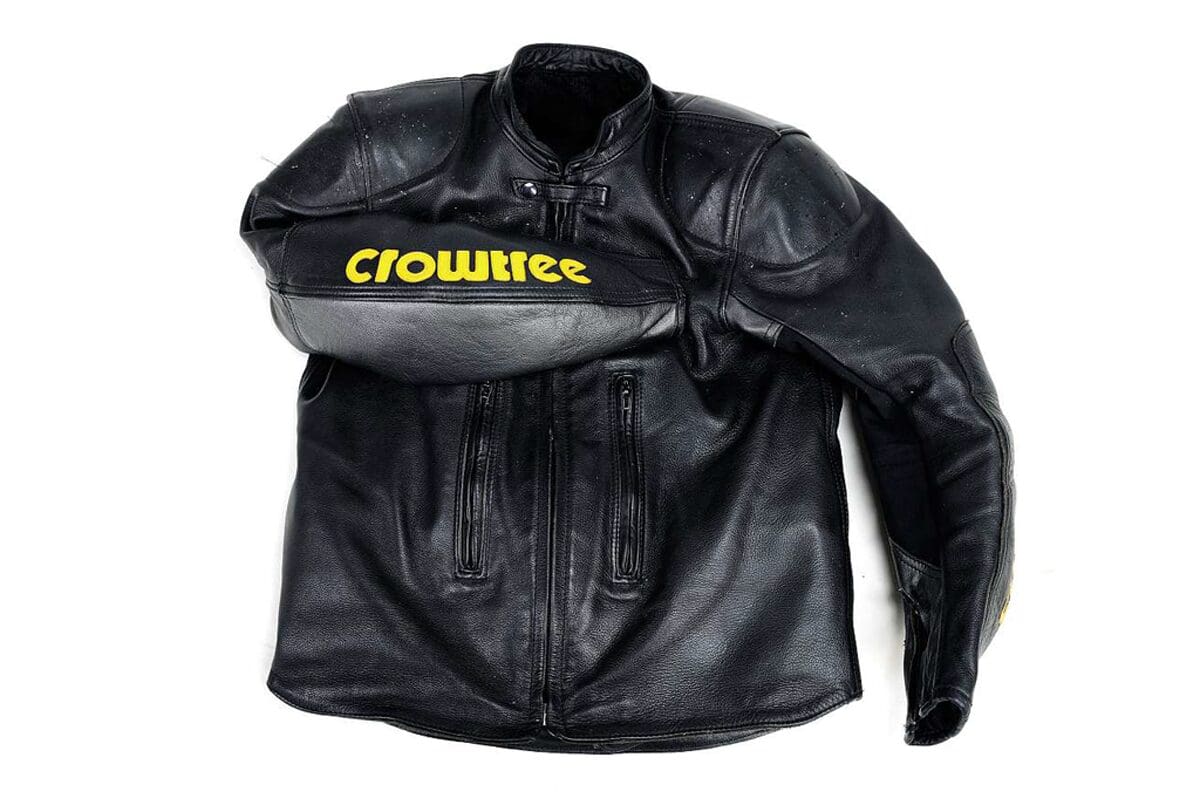
Leathers
No one quite understands how the humble heifer developed a skin that survives being thrown off a motorcycle at 70mph. Darwin, unfortunately, died before getting round to it. But we should be very grateful because even after all these years, there is nothing better to save your backside should the worst happen.
Good leathers are worth every penny. They look cool, they give you mobility as you shift your weight on the bike, you barely notice they’re on your back and, should the worst happen, they will save your skin. Literally. Bad leathers feel awkward, make you look like a tasteless golfer and split apart on impact exposing bare flesh to Mr Macadam’s finest.
Buying a good set is simple. Go to one of the few remaining made-to-measure firms such as Crowtree or BKS and have a bespoke suit built. It’ll cost you but it is also worth every penny. Failing that, read this guide and check our basic recommended specs against the ones on the label.
Construction
Construction is the most important. The right leather (generally cowhide with a minimum thickness of 1.2mm, but more recently kangaroo has become popular because it is lighter and more flexible), put together properly with the right stitching (double or triple rows with concealed stitching in the impact areas that won’t burst open the moment you hit the deck) and reinforcing panels on the key impact areas (backside, elbows, shoulders and knees).
Some suits have hard, external armour on the impact points. This is good as long as it is fitted over the leather panels and not instead of one because if it comes away in a crash you need to know there’s something underneath it.
Two-piece, zip-together suits are best for the road, one-piece race suits are really only meant for track use. Many modern suits use stretch fabrics between the legs, behind the knees and inside the elbows (which are unlikely to ever be impact zones) to add flexibility and extra movement on the bike. Finally, zips. They get a lot of use and are almost always the first thing to break on a set of leathers. So buy a suit with strong, chunky zips fitted and treat them gently.
Fit
As before, try the suit on and sit on a bike in the showroom with a similar riding position to the one you own. Most off the peg suit problems are tightness at the back of the knees and ankles (legs too long or short), shoulders and especially the collar which needs to be tight enough to keep the draughts out, but not so stiff that it chokes you.
Fit at the elbow and knees are especially important because any slack here and the armour can move around in a crash, leaving you unprotected.
Aches from your shoulders are often caused by the suit being too tight around the waist. I’ll be as diplomatic as I can here. A big belly pushes out on the suit. The leather only has a certain amount of give and as it pushes outwards, it drags the shoulders of the jacket down, which makes the armour dig into your shoulders.
The simple answer is to buy a suit that fits you – don’t try to squeeze into one that doesn’t. And remember, the suit is designed to fit best while on the bike, not off it. So that comfort on the move may have to be offset by a slightly saggy backside when walking around.
Protection
Protection comes in two forms. The initial impact should be absorbed by high-quality CE-marked body armour in the knees, elbows, hips, shoulders and back. Some riders prefer to use a separate back protector that straps on like a turtle shell. If this is you, then make sure you try the suit and back protector on together.
Knee sliders serve more than just a fashion function too. There are several major blood vessels (including arteries) that run around the kneecap. Bust one of these and you could be in serious trouble. So, a tough, plastic knee puck is invaluable in a crash.
Having hit the deck, the next thing your suit must do is slide along the ground without wearing through or bursting apart at the seams. Good quality, thick cowhide can survive long enough before wearing through waiting for your body to stop sliding. The best suits have double layers (pie below) on all the important impact areas (because the most wear happens on impact and the following couple of seconds).
But Daisy’s finest cowhide is no use at all if the stitching holding your suit together wears through or bursts open on impact. Exposed stitching should all be double layered and there should be at least one layer of concealed stitching.
Features
The last few years have seen an increasing number of waterproof leather suits. Some are very thick and mega-expensive, others less so. Most of them work really well, but don’t mistake them for an all-seasons suit.
You might be dry, but you’ll still be freezing cold in November. The other dilemma with leathers (especially race suits) is pockets. A good fitting suit won’t have room for more than a wallet, keys and money. Any more and you’ll have stuff digging into your ribs.
Vents are essential for track riding but rarely any use on the road unless you only ride on the hottest of days. Aerodynamic humps on the back help racers squeeze the last half an mph out of a bike when tucked in on a straight, but are little use to anyone else. And besides, if that theory is right, surely we should be watching camels, not horses winning the 3.35 at Kempton Park.
Price
If you want a simple, black suit with no frills, but decent protection then £500 should be enough. Big chains like Hein Gericke offer a wide range of decent kit for sensible money, but plenty of other brands do a good suit for this money.
Below that, you need to be careful. Check the design and specs against our guide above. A £1000 one-piece race suit will certainly be comfortable and should protect you in a crash, but might well be destroyed beyond repair in doing so.
Thicker, heavier road kit might not be quite so comfortable, but could still be usable after a spill. Just because your favourite racer wears one doesn’t make it the best for road riding. Most racers would probably ride naked if it made them half a second quicker – protection is not at the top of their lists when choosing kit.
A made to measure suit will cost between £1000-2000 but will fit you perfectly, be built to last and you’I I feel the safest you can possibly be.
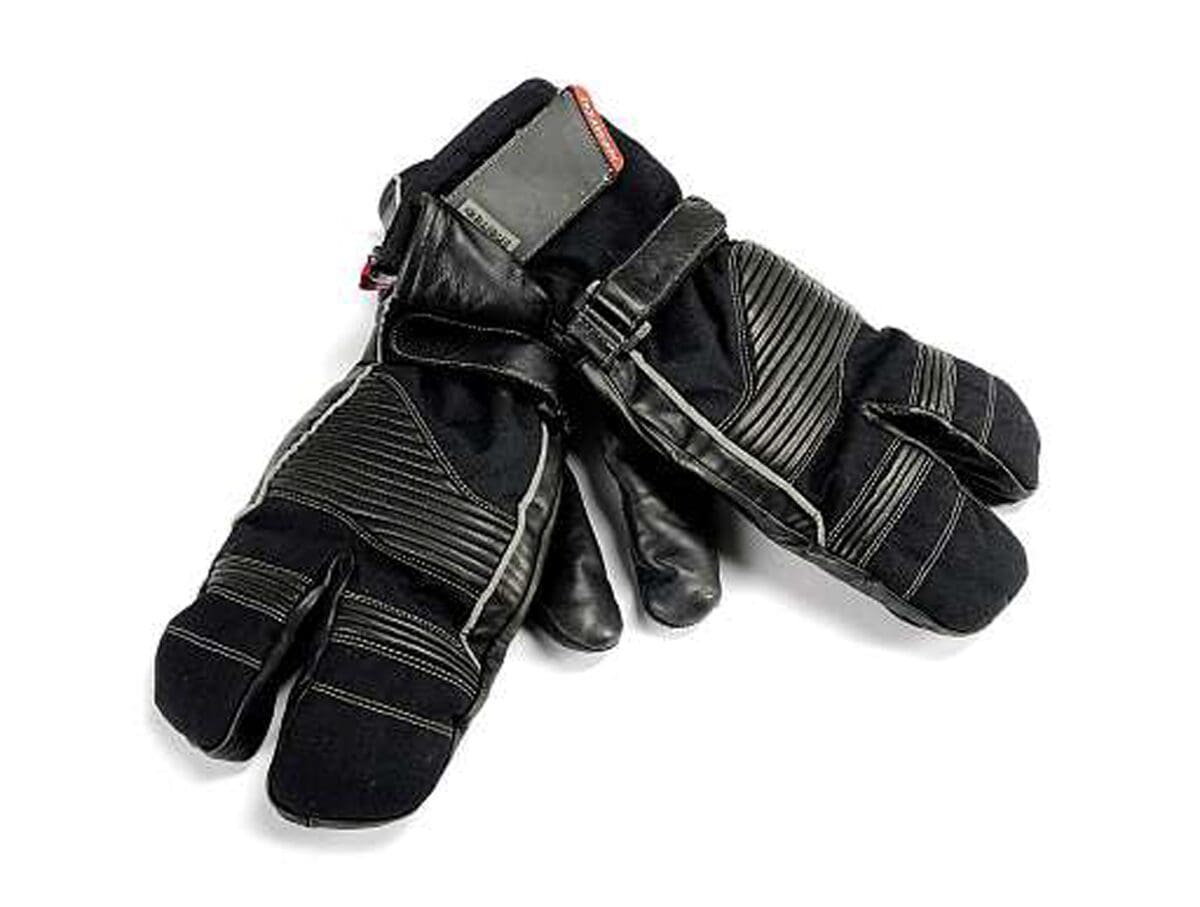
Gloves
Cold hands hurt. Overwhelming, distracting, all-consuming hurt. Wet hands aren’t much better. And should you take a tumble, chances are it’ll be your hands that hit the deck first. So good gloves are essential. And, unless you are rich enough to afford a different pair for summer and winter and psychic enough to predict the weather, they have to do three very specific things. Keep you warm, keep you dry and protect you in a crash.
Oh, and then there’s the matter of feel. Throttle, brake and clutch -three of the most sensitive controls on your bike, all needing a delicate touch. So your gloves also need to be thin enough to letf1ngers dance on the controls. Which is why a decent bike glove costs way more than something for skiing.
The materials used are similar in some ways, but the construction and design are very different. Bike gloves are one item where it is worth spending decent money and the reality is that the best solution is to have a thin pair of armoured leather gloves for summer and a thicker pair of waterproof warm ones for winter.
For most of us though, it’s better to compromise with a three-season glove that’s waterproof with some insulation, but still thin enough to offer good feel.
Construction
Ideally a leather outer with double layers on the palm, finger tops and running along the bottom of the hand up the outside of the little finger. Plastic or carbon knuckle protection resists impact strongly but check that it fits snugly and doesn’t dig in.
Some race gloves have a link piece between the little and ring finger to prevent a common injury to the little finger in a crash. Cuffs should be long enough to not leave a gap between jacket and glove and should have two separate fastenings – one around the wrist and another to keep the cuff tight to your jacket.
A glove that comes off easily in a crash is no use whatsoever. Plenty of leather gloves are now available with a waterproof lining. But if you want warmth too you’ll have to sacrifice some feel for a bit of added bulk.
A suede visor wipe on the thumb or forefinger is very useful in wet weather- less useful are the rubber windscreen wipers fitted to some gloves.
Most proper winter gloves are fabric with leather panels at the impact points. This makes them easier to pad out for extra warmth, but less protective. The warmest ones have a strange two-fingered ‘lobster-claw’ design which looks weird but works well.
Fit
Tight gloves constrict fingers and exaggerate the vibrations coming through handlebars leading to the dreaded white finger. So they should be loose enough to be comfy wrapped round a handlebar for hours on end, but not so slack that excess leather scrunches up under your palm.
The fit and fastening of the cuffs is crucial -if you can pull them off easily, you’ll be vulnerable in a crash.
Price
Expect to pay at least £60-100 for a decent pair of summer gloves with proper construction and good knuckle armour. Warm fabric winter gloves can be bought from about £50 upwards and a decent three season waterproof leather glove will be somewhere around £100.
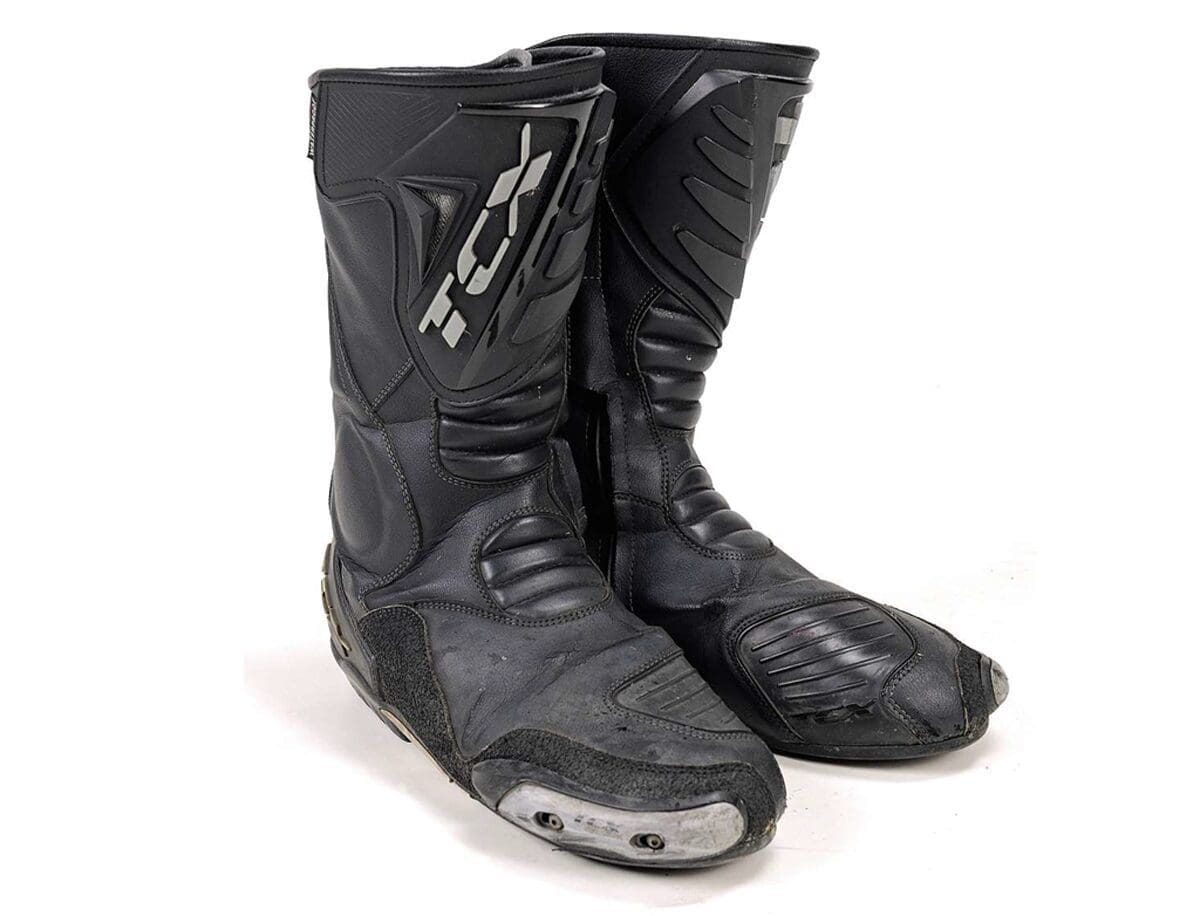
Boots
Tempted to ride in that old pair of army boots or Doc Martens? Think about this. In a boot test, I reported on a few years back, both army boots and DMs were freezing cold (because the wind gets past the laces), leaked like a sieve (same reason), offered no impact protection in an accident and only a fraction of the abrasion resistance of an armoured plastic boot.
No item of motorcycle clothing has advanced so quickly in the last 10 years as boots. And that’s a good thing because your feet are so very vulnerable. Not just from the cold and wet, but the twists and impacts suffered in a spill too.
The best modern bike footwear is like high-tech, lightweight ski boots. All kinds of bracing and external armour, waterproof, breathable, warm and still offering enough feel for the controls and movement on the footpegs. All this and you can still walk in them too. All for around £200-300.
Many are now made from ‘Lorica, which is a synthetic leather that is much cheaper than the real thing but much less abrasion resistant too. Thankfully, the design of modern boots means most of the vulnerable.
Fit
Simple this one. What size are you? Okay, maybe it’s not quite that simple. Many of the sportier boots are designed in Italy, where it seems that people have different shaped feet to us. So try before you buy and expect to maybe go a half size up from normal.
If you’ll be riding all year then take a pair of thick winter socks when you buy. Better to be a tiny bit roomy in summer than cut off your circulation in January. Also, take the rest of your riding kit with you so you can be sure that your trousers either f1t over or inside the boots (whichever you prefer).
Construction
For many of us, a simple leather boot with a little protection around the ankle is fine. And besides, those race boots look I ike something out of Star Wars. Yes, but. .. all that armour works. It might look clunky and some of it squeaks like a drunken mouse when you walk, but it works so well that, if you can afford it, you’re daft not to.
The more expensive boots have a separate inner boot, like a ski boot. These can be a little less comfortable to walk in but should be fine on the bike. For boots without the armour, leather is stronger than Lorica. Replaceable plastic toe sliders are worth having because as your riding gets more confident, the lean angles increase through corners and at some point you might be scuffing your toes on the floor.
A waterproof membrane is essential because you only want one pair of boots, but don’t forget that if you tuck your trousers inside your boots the water will still run down inside and you’ll get wet.
Finally, check the fastenings. Most have a side zip and Velcro flap and the weak spot is always the toggle on the zip because it needs a good tug to get the zip up. So always go for the meatiest looking toggle you can. Some boots also have a drawstring innermake sure this is comfortable when the strings are tucked inside the boot.
Price
You can buy a decent, waterproof pair of boots for around £100, but the real value comes at around £200. For this money, you can buy a decent pair of armoured, waterproof race-style boots that’ll last 60,000 miles or more.
£300 gets a pair of good quality high-tech race boots and for the very well-heeled (ho-ho) the Rolls-Royce of race boots is a flash pair of German Daytona Security Evo llls at £829.


